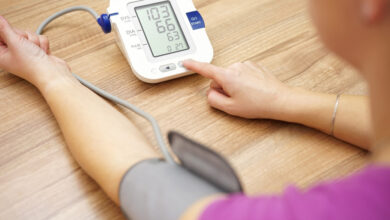Story: Maritza Manresa
Vein disease is a serious matter that should not be overlooked and addressed as any other venous disorders such as heart disease or high blood pressure. It is a condition that if left unattended can cause serious health issues, even death.
However, to better understand vein disease, it helps to have a better understanding of the venous system and how it works. The human venous system consists of three systems of veins. The first one, the superficial system is found just below the surface of the skin and it is made up of what is called the great and small saphenous veins and their branches. This system of veins carries the blood from just below the skin and tissues and drains it into the deep vein system, which is located between the muscles of the leg. It is this deep system that is responsible for carrying 90% of the blood back to the heart. The third system of veins consists of what are called perforating veins, which are the veins that carry blood from the superficial vein system to the deep vein system. Varicose veins, which is one of the most common forms of vein disease, develops in the superficial system.
“Vein disease is multifaceted and so are the reasons that put you at risk,” said Deanna Shelpman, Registered Vascular Technologist with Ocala Health Vascular Surgery. For instance, some of the risk factors of vein disease can be as simple as lack of exercise, extensive use of high-heeled shoes, or even wearing tight fitting clothes. However, it can also be caused by other more complex factors such as heredity, age, obesity, dehydration, and pregnancy.
Pregnancy, you may say? Deep Vein Thrombosis (DVT), more commonly known as blood clots, can be developed during pregnancy. It is caused by the way the baby lies causing pressure on the iliac veins which run deep in the pelvic area and rise to the lower portion of the abdomen. Blood clots can also develop due to prolonged bed rest as a result of surgery or trauma. Additionally, people who suffer from cancer can also develop blood clots. Not only can the cancer itself trigger the blood clots, but it can also be that cancer treatment that damages the blood vessels, thus causing blood clots. Congenital clotting disorders and hormone therapy which causes the blood to be thicker, can also cause blood clots. Essentially, “where blood slows, clot grows,” said Shelpman. DVT’s form in the deep veins, and are extremely dangerous. Not only can they cause partial or complete blockages of the blood flow, they can also break away from the wall of the vein, traveling through the veins and ultimately lodge in the lungs causing an embolism.
The best way, according to Shelpman, to treat vein disease is by taking preventative measures. If you have suffered a trauma and will be in bed rest for a long time, know that you are going in for surgery, or are scheduled to have cancer treatment the best way to prevent blood clots from forming, is by taking blood thinners (of course prescribed by a health care professional) and/or having pneumatic socks. These socks, that compress and decompress your legs while laying down, promote blood flow by triggering the release of the body’s natural blood thinner. In severe cases where blood clots actually develop, the patient can be treated in the hospital for seven days with high doses of blood thinner. However, if you cannot take blood thinners, the other option available is to deploy what is called an Inferior Vena Cava or IVC filter. An IVC filter is a small cone-shaped device – like a little umbrella, that is implanted in the inferior vena cava just below the kidneys. The filter is designed to prevent the blood clot from traveling to the heart and lungs.
Another commonly known type of vein disease is Chronic Venous Insufficiency (CVI). Basically CVI is the result of damaged valves in the veins, which causes the blood to pool in the legs. A healthy vein will have fully functional vein valves which keep the blood moving in one direction only, and that is back to the heart. On the other hand, an unhealthy vein is one that has damaged valves that allow the blood to move in both directions thus elevating the pressure in the vein, thus leading to inflammation and swelling, discomfort, damage to the skin such as discoloration, ulcers on the legs, and varicose veins.
Varicose veins, in addition to being caused by back flow or pooling of blood in an unhealthy vein, can also be hereditary. It is some type of genetic defect where the veins are not very strong and if you happen to be someone who has to be standing up for extended periods of time, for work or any other reason, it will only worsen the condition. Contrary to common misconception – more than likely due to their appearance – varicose veins are not necessarily a risk factor for deep vein thrombosis. They can cause, however, superficial phlebitis causing the vein to show and break causing a great deal of pain.
The best way to keep varicose veins (and spider veins) from getting worse is by staying hydrated, exercising and using compression stockings.
Compression stockings are great in helping to relieve the symptoms of varicose veins. However, you know it is time to seek medical assistance when mild symptoms of varicose veins escalate to experiencing: leg heaviness and aching especially of the end of the day, painful varicose veins, swelling in the leg and ankle, color changes in the lower legs, and ultimately ulceration in the lower leg area (feeling itchy tingly varicose veins). According to Shelpman, if varicose veins turn into ulcers then they are very difficult to treat because it is dirty blood just sitting there. This dirty blood does not have any oxygen or glucose, it has waste product from cells and the lymph, thus causing the skin to break down. However, when varicose veins get bad enough and are caused by superficial vein problems, not deep vein problems, then there is an in-office procedure available to alleviate the problem. The procedure consists of inserting a catheter into the diseased vein and closing it down, thus allowing the blood to flow as it should though the other healthy veins.
With more than 24 million Americans suffering from vein disease and the number continuing to rise, prevention and early treatment of vein disease is the best weapon against the battle with this troublesome disease.






